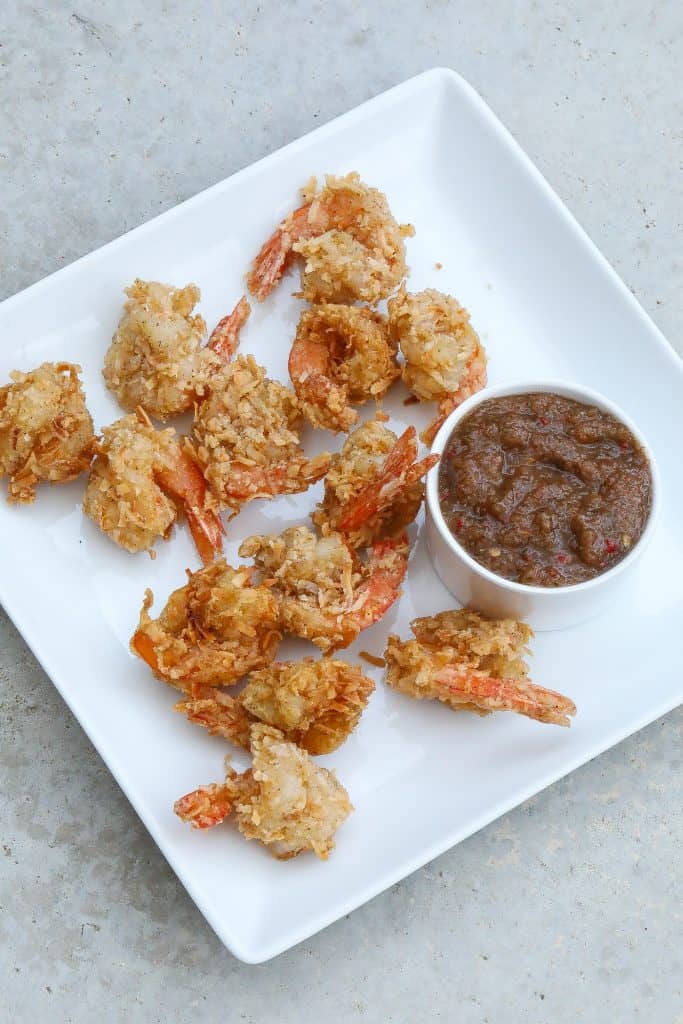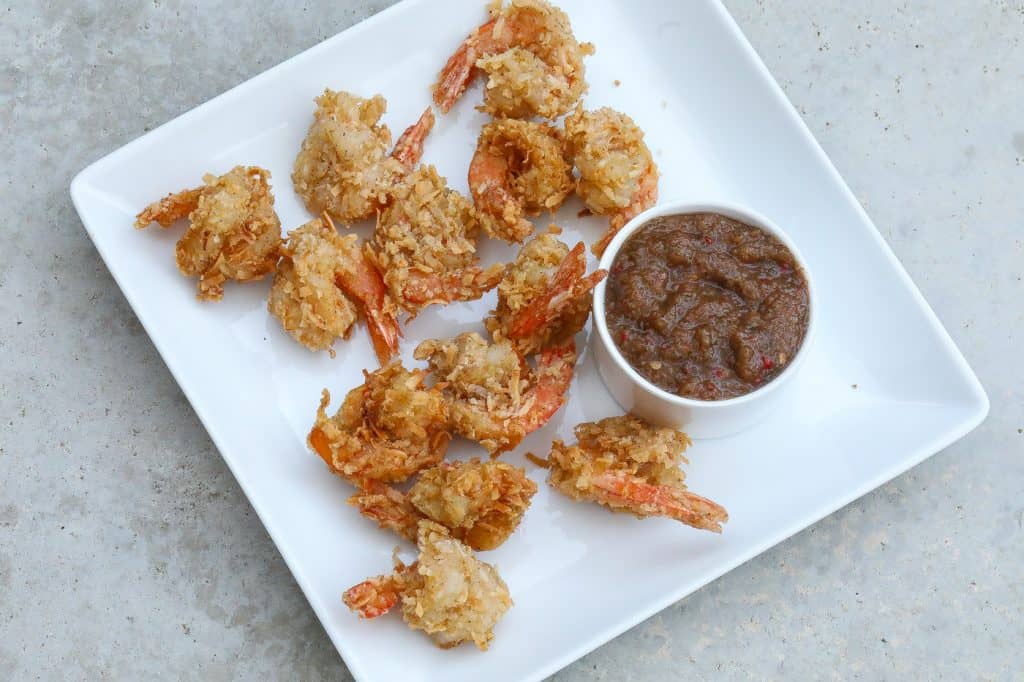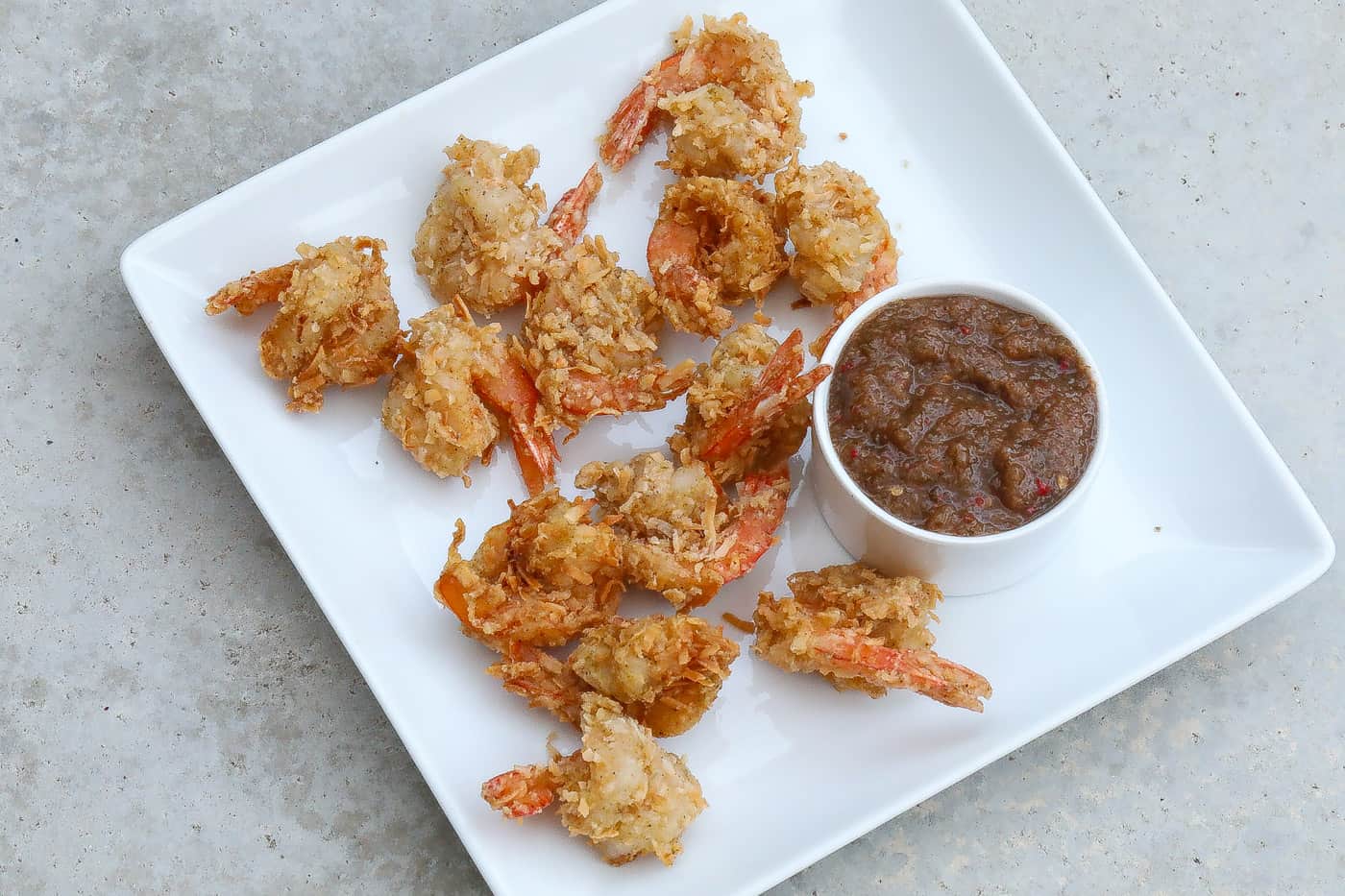This post may contain affiliate links via Amazon's affiliate advertising program. See privacy policy
Related Shrimp Recipes:
Take a fantastic tropical culinary voyage with this irresistible coconut shrimp recipe that will transport your taste buds to that beach life and those lush flavors of the tropics.
Delicately coated in a crisp, golden layer of shredded coconut, each succulent shrimp offers a delightful contrast of textures, while the subtle sweetness of the coconut complements the natural brininess of the seafood and slight heat from the hot sauce.
With every bite, you'll be transported to an island paradise, savoring the harmony of flavors and the sheer indulgence of this beloved coastal delicacy.
Delicious coconut shrimp - sweet flavor, extra crunchiness, and a nice golden color, I mean what else could you want! How about a lil heat to make things fun and a bit more interesting.
These shrimp have that coconut flavor inside and out and are fried perfectly leaving flavorful, tender, and juicy fried shrimp. The added dipping sauce just takes things to a different level.
These make for great finger food appetizers. Not only do they taste great but they present well if you're serving them up for a party with guests and all.

Origin of Coconut Shrimp in the Caribbean
Coconut shrimp has become a beloved dish in the Caribbean, known for its tropical flavors and culinary heritage. While the exact origins of coconut shrimp in the region are difficult to trace, it is believed to have evolved from the rich culinary traditions of various Caribbean islands. With its abundance of coconut trees, the Caribbean has long celebrated the use of coconut in their cuisine, incorporating it into both savory and sweet dishes.
The combination of fresh shrimp coated in shredded coconut perfectly encapsulates the vibrant flavors and coastal influences of the Caribbean, making coconut shrimp a cherished part of the region's culinary repertoire. Today, this delightful dish can be found in many Caribbean restaurants and is enjoyed by locals and visitors alike, serving as a delicious reminder of the sun-drenched shores and tropical paradise that the Caribbean is known for.
Recipe Inspiration
Most coconut shrimp recipes fall on the very sweet side. I like sweet but not too sweet coconut shrimp. But I also like for my coconut shrimp to be coconutty. Full candor - this is not your typical beer batter soaked, panko bread crumb encrusted and deep fried shrimp. This version is heavier on the coconut flavor, plussed up on the light crunchy texture meter, and has a much more complex flavor profile beyond just coconut.
Given this I tweaked a couple of things. One - I added hot sauce to balance against the sweet. Two - I added more cococonut flavor by going with both coconut cream and flakes in place of the normal panko breadcrumbs.
Beats and Eats (music to pair with deep fried coconut shrimp)
This is a fun, hit and run kinda recipe. The shrimp is really good, but you'll want to save your appetite from the main dish.
Coconut Shrimp Ingredients
- Jumbo Shrimp - peeled and deveined
- Egg Whites
- Water
- Coconut Cream
- Hot Sauce
- All-purpose flour
- Potato Starch
- Coconut Flakes
- Allspice
- Paprika
- Kosher Salt
- Pepper
- Optional spice - garlic powder
- Sugar
- Oil for frying - vegetable oil, peanut oil, or canola oil. Note I don't recommend coconut oil because at high temperatures required for frying you lose benefit of coconut flavor.
Dipping Sauce Ingredients
- Mango or Peach Nectar
- Red Onion
- Garlic Clove
- Habanero or Scotch Bonnet Pepper - substitute other peppers or hot sauce like sriracha sauce
- Cilantro
- Optional ingredient - orange marmalade
How To Make This Fried Butterfly Coconut Shrimp Recipe
Make the Egg Wash
Mix hot sauce, egg whites, coconut cream, and water in a mixing bowl. Set aside.
Make the Dredge
Mix the flour, starch, coconut flakes, and spice mix in a separate mixing bowl.
Prepare the Shrimp
Pre-heat your fryer to 325 degrees.
Wash and then dry the shrimp.
Devein shrimp from both sides of the shrimp. I use a sharp paring knife and cut incisions on both sides to remove the veins either by hand or using sharp end of the knife.
Butterfly the shrimp by slicing through the back of the shrimp. Cut deep about halfway through the shrimp.
Dip shrimp in the egg mixture and dredge the shrimp in the flour mixture. Place in hot oil and fry shrimp (I used a deep fryer) in batches 3-4 minutes. Repeat for any remaining shrimp. Shrimp should be a nice deep golden brown color. Remove to a wire rack for cooling/draining or a paper towel lined plate.
Make the Sweet Chili Sauce
Puree all the ingredients together in a blender. Place the puree in a saucepan and cook on low heat for 15 minutes. The sauce will reduce and thicken. Set aside.

- Dipping Sauces: Provide an array of dipping sauces to complement the flavors of the coconut shrimp. Options like sweet chili sauce, tangy mango salsa, or a zesty citrus aioli add a burst of flavor and enhance the overall experience.
- Rice or Quinoa: Serve coconut shrimp alongside a bed of fluffy white rice or nutty quinoa. The grains provide a neutral base that helps balance the richness of the shrimp and allows the flavors to shine.
- Fresh Salad: Pair coconut shrimp with a refreshing salad for a light and balanced meal. A crisp green salad, a tropical fruit salad, or a cucumber and mint salad add a refreshing element to the dish.
- Steamed Vegetables: Serve steamed vegetables like broccoli, asparagus, or snap peas as a side dish. The vibrant colors and tender texture of the vegetables complement the crispy coconut shrimp.
- Stir-Fried Vegetables: Prepare a colorful stir-fry with an assortment of vegetables like bell peppers, carrots, zucchini, and mushrooms. The stir-fried vegetables provide a flavorful and nutritious accompaniment to the coconut shrimp.
- Tropical Fruit Salsa: Create a vibrant tropical fruit salsa with ingredients like pineapple, mango, red onion, jalapeno, and cilantro. This sweet and tangy salsa adds a burst of freshness that complements the coconut shrimp.
- Fried Plantains: Fry up some ripe plantains for a deliciously sweet and caramelized side dish. The natural sweetness of the plantains pairs well with the crispy texture of the coconut shrimp.
- Coleslaw: Serve a creamy and tangy coleslaw alongside the coconut shrimp. The cool and refreshing flavors of the slaw provide a contrast to the warm and crispy shrimp.
How To Butterfly Shrimp
Butterflying shrimp allows them to cook more evenly and promotes a visually appealing presentation. This technique is commonly used in various shrimp recipes, including coconut shrimp, where the butterfly shape helps to hold the coating in place during frying or baking.
To butterfly shrimp, follow these steps:
- Start by holding the shrimp with one hand and a small sharp knife with the other.
- Locate the back of the shrimp where the shell meets the flesh. Insert the knife into the back, about halfway through the thickness of the shrimp.
- Carefully slice along the back, lengthwise, until you reach the end of the shrimp, ensuring not to cut all the way through.
- Open up the shrimp, gently spreading it apart like a butterfly's wings. The shrimp should lie flat and resemble the shape of a butterfly.
- If desired, use the tip of the knife to remove the vein running along the back of the shrimp.
- Repeat the process for each shrimp until they are all butterflied.
What to serve with coconut shrimp
Coconut shrimp pairs wonderfully with a variety of side dishes and accompaniments. Here are some options to consider when serving coconut shrimp:
Remember, these are just suggestions, and you can mix and match to create a meal that suits your preferences. The goal is to provide a balance of flavors and textures that enhance the enjoyment of the coconut shrimp.
Cooking Considerations and Recipe Tips for Making Coconut Shrimp
- Ensure the shrimp are properly thawed and patted dry before coating them with the coconut mixture. This helps the coating adhere better and ensures even cooking.
- Use fresh, large shrimp for the best results. Larger shrimp provide a more substantial bite and allow for a generous coconut coating.
- Toast the shredded coconut before using it in the coating for added flavor and crunch. Spread the coconut on a baking sheet and bake in a preheated oven at 325°F (165°C) for a few minutes until golden brown.
- Be mindful of the oil temperature when frying the coconut shrimp. Maintain a temperature of around 350°F (175°C) for optimal results. If the oil is too hot, the coating may burn quickly, while oil that is not hot enough can result in greasy shrimp.
- Fry the coconut shrimp in small batches to avoid overcrowding the pan. Overcrowding can lead to uneven cooking and a soggy coating.
- Use a slotted spoon or tongs to gently flip the shrimp while frying to ensure they cook evenly on all sides.
- Drain the cooked coconut shrimp on a paper towel-lined plate to remove any excess oil and maintain their crispiness.
- Serve the coconut shrimp immediately for the best texture. The longer they sit, the more the coating may soften.
- Experiment with different dipping sauces to complement the flavors of the coconut shrimp. Sweet, tangy, or spicy sauces can add an extra dimension of taste.
- If baking the coconut shrimp, preheat the oven to a high temperature (around 425°F or 220°C) and place the coated shrimp on a parchment-lined baking sheet. Lightly spray the shrimp with cooking oil before baking to help them brown and crisp up.
Additional Considerations
Choose jumbo shrimp. The larger the better. Leave tails on for easier handling.
Feel free to buy deveined shrimp to save time.
Definitely butterfly your shrimp. This increases the surface area of the shrimp meaning more coconut flavor for the shrimp.
Use your hot sauce of choice or go without.
Coconut is sweet and there is added sugar in this recipe so be sure to cook at lower than normal frying temperatures. 325 degrees F is the sweet spot.
The dip recipe included is a great mix of sweet heat that pairs well with the shrimp. Feel free to make your own or go with a store bought sauce like thai sweet chili sauce.
These coconut shrimp make for a great appetizer. Serve with others like lemon pepper wings or brisket stuffed avocado. Also, a good collard greens recipe would work well.
For a milder dip, remove the seeds and veins from the pepper.
Choosing The Right Shrimp
When making coconut shrimp, it is generally recommended to use large or jumbo shrimp. The larger size of the shrimp allows for a substantial coconut coating, resulting in a more satisfying and flavorful bite. Large shrimp also tend to have a firmer texture, which pairs well with the crispy exterior of the coconut coating.
Look for shrimp labeled as "large" or "jumbo" at your local seafood market or grocery store. Opting for fresh shrimp, if available, ensures the best flavor and texture. However, frozen shrimp can also be used as long as they are properly thawed and patted dry before coating them with the coconut mixture.
Frequently asked questions about Making Coconut Shrimp
Can I use frozen shrimp for coconut shrimp?
Yes, you can use frozen shrimp for coconut shrimp. Thaw the shrimp completely before starting the recipe and pat them dry to remove any excess moisture. This will help the coconut coating adhere better to the shrimp.
Can I bake coconut shrimp instead of frying them?
Yes, you can bake coconut shrimp. Preheat the oven to a high temperature, around 425°F (220°C), and place the coated shrimp on a baking sheet lined with parchment paper. Lightly spray the shrimp with cooking oil and bake for about 12-15 minutes, flipping halfway through, until they are golden and crispy.
Can I use sweetened shredded coconut for coconut shrimp?
Sweetened shredded coconut can be used for coconut shrimp, but keep in mind that it will add extra sweetness to the dish. If you prefer a more balanced flavor, unsweetened shredded coconut is a better choice.
Can I make coconut shrimp ahead of time?
While coconut shrimp is best enjoyed immediately after cooking for optimal crispiness, you can make them ahead of time and reheat them. To reheat, place the cooked coconut shrimp on a baking sheet and bake in a preheated oven at 350°F (175°C) for about 8-10 minutes until heated through.
For other shrimp based recipes try these:
make this coconut shrimp recipe
In conclusion, this coconut shrimp recipe is a tantalizing blend of tropical flavors and culinary delight. The combination of crispy coconut coating and succulent shrimp creates a harmonious symphony of textures, while the subtle sweetness of the coconut adds an exotic twist.
Whether enjoyed as an appetizer or a main course, this dish promises to transport you to a sun-drenched paradise, igniting your senses with every delectable bite. Prepare to embark on a culinary journey that embodies the essence of coastal indulgence and leaves you craving more of this irresistible treat.
If you make this delicious Caribbean Coconut shrimp recipe, please come back and leave me a comment below with your feedback. Definitely take a photo of the dish and be sure to tag #foodfidelity so that I can see them.
You can also keep up with my food exploits as well as original recipes! You can find me on Instagram, Facebook, Twitter, and Pinterest. If you like any of the music you find on the site, visit me at Spotify to find curated monthly playlists.
Lastly, go to my YouTube channel and subscribe to be notified when new weekly videos are uploaded.
Equipment
- fryer
Ingredients
Coconut Shrimp Ingredients
- 10-12 jumbo Shrimp
- 2 whole Egg Whites
- 1 cup Water
- 1 cup Coconut Cream
- 1 teaspoon Hot Sauce
- 1 cup All-purpose flour
- ½ cup Potato Starch
- 2 cups Coconut Flakes
- 1 teaspoon Allspice
- 1 teaspoon Paprika
- ½ teaspoon Kosher Salt
- ½ teaspoon Black Pepper
- 1 teaspoon Sugar
Dipping Sauce Ingredients
- 1 ½ cups Mango Nectar Peach can be substituted
- 1 small Red Onion
- 4 cloves Garlic
- 1 whole Scotch Bonnet Pepper substitute habanero
- ¼ cup lightly packed Cilantro
Instructions
Make the Egg Wash
- Mix hot sauce, egg whites, coconut cream, and water in a mixing bowl. Set aside.
Make the Dredge
- Mix the flour, starch, coconut flakes, and spice mix in a separate mixing bowl.
Prepare the Shrimp
- Pre-heat your fryer to 325 degrees.
- Wash and then dry the shrimp.
- Remove the veins from both sides of the shrimp. I use a sharp paring knife and cut incisions on both sides to remove the veins either by hand or using sharp end of the knife.
- Dip shrimp in the egg wash and dredge the shrimp in the flour mixture. Fry the shrimp 3-4 minutes. Remove to a wire rack for cooling.
Make the Dipping Sauce
- Puree all the ingredients together in a blender. Place the puree in a saucepan and cook on low heat for 15 minutes. The sauce will reduce and thicken. Set aside.
Video



Anaiah
Friday 6th of August 2021
This coconut shrimp was AMAZING! And the dipping sauce was perfect and gave it a nice kick. Definitely making this recipe for my next family gathering!
Ramona
Thursday 5th of August 2021
Wow, coconut and shrimp together sound like heaven! I am really excited to make this recipe for me and my family since we haven't tried this before. Thank you for sharing this recipe, I cant wait to make this!
Maren
Tuesday 3rd of August 2021
Definitely going to make this for my Labor Day bbq cook out in a few weeks! Thank you so much for sharing this recipe!
Shobee
Monday 2nd of August 2021
I love coconut and shrimp.Combine them and I am drooling.